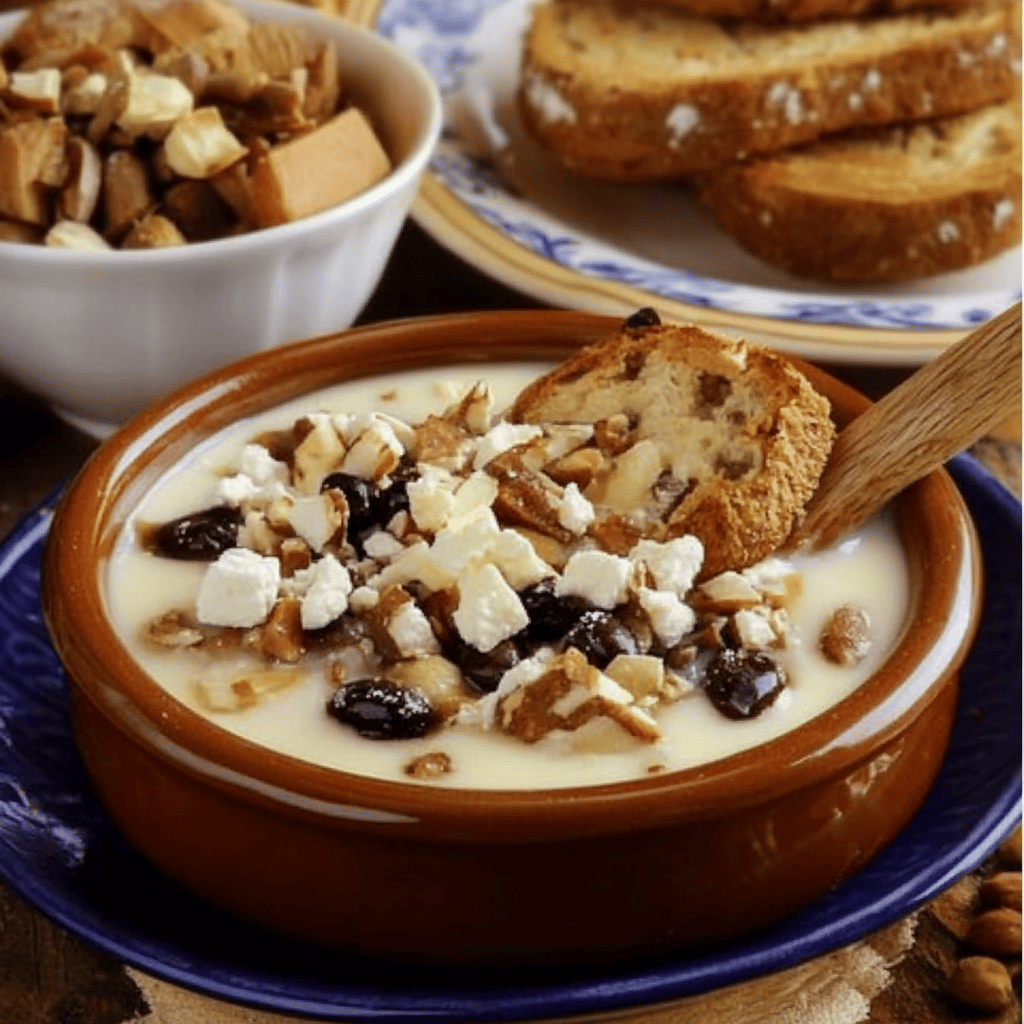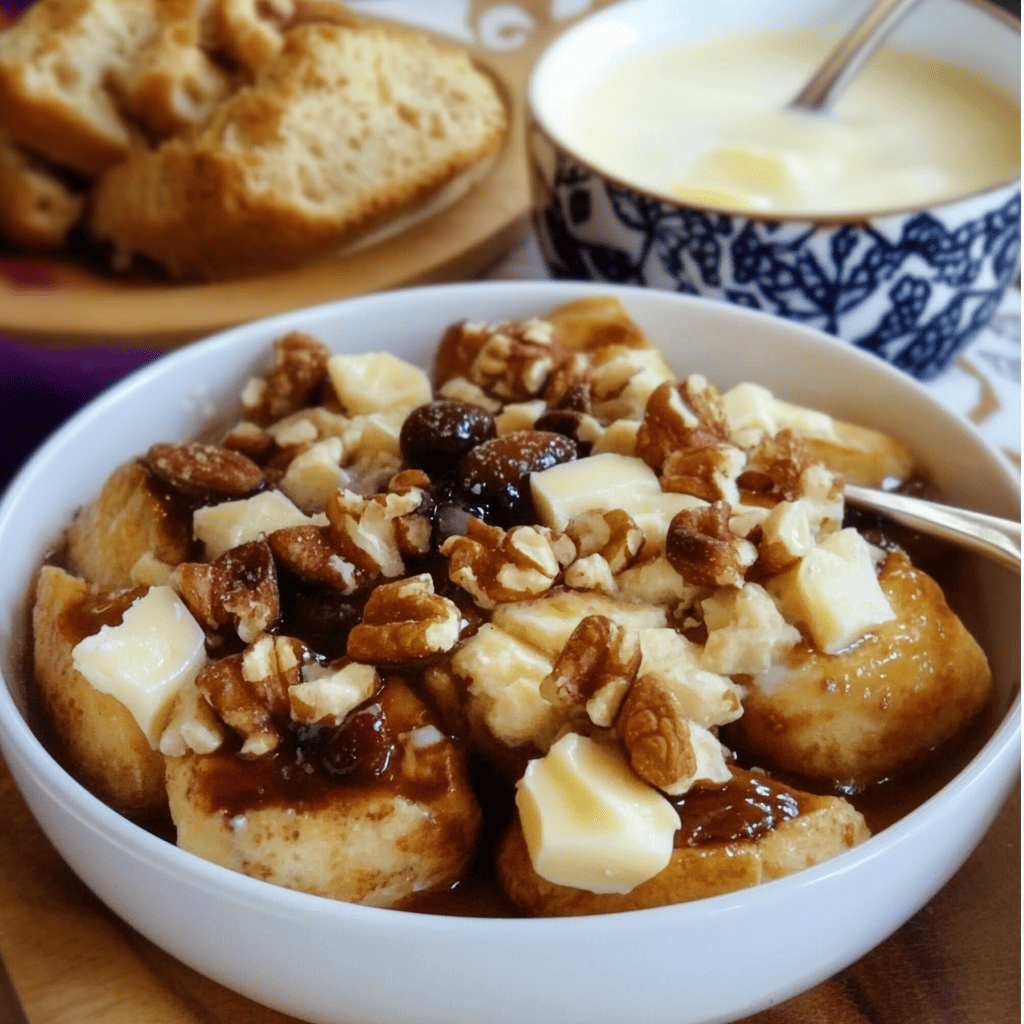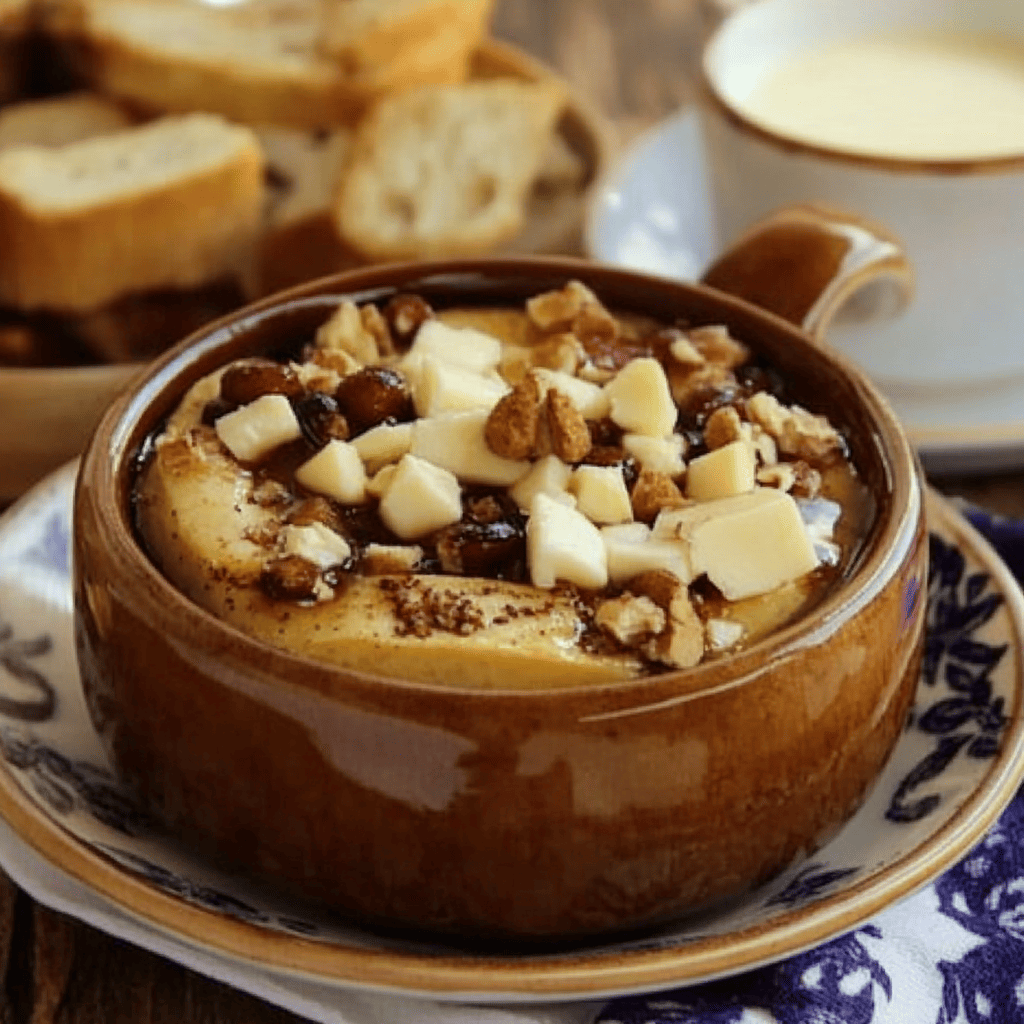CAPIROTADA
Introduction
Capirotada is a traditional Mexican dessert enjoyed primarily during Lent and Holy Week. Its origins date back to the colonial era, and its preparation varies regionally. It is a dish with profound cultural and religious significance, as its ingredients represent elements of the Passion of Christ.
Capirotada is a traditional Mexican dessert deeply rooted in the country’s culture and religion. It’s especially popular during Lent and Holy Week , where it’s enjoyed not only for its sweet flavor and unique blend of ingredients, but also for its spiritual symbolism.
This dish has its roots in the colonial era, adapting Spanish influences with local ingredients. Capirotada, more than just a dessert, represents an act of faith and tradition. Each of its components has a religious significance: the bread symbolizes the body of Christ, the piloncillo honey represents his blood, the cinnamon sticks evoke the cross, and the cloves, nuts, and cheese are associated with the nails of the crucifixion.
Furthermore, capirotada has transcended generations, becoming a dish that varies across regions of Mexico. While some recipes add almonds, coconut, or fruit, others prefer to stick to the more classic version with brown sugar, toasted bread, raisins, and cheese.
In this introduction, we’ll explore the origin of capirotada, its distinctive ingredients, and its cultural significance. Capirotada isn’t just a dessert; it’s a living symbol of Mexican traditions, uniting history, religion, and gastronomy in every bite.
History and origin
Capirotada has its roots in Spanish cuisine, where similar dishes have been prepared since the Middle Ages. In Mexico, the recipe evolved with the incorporation of local ingredients such as piloncillo, cheese, and nuts. During colonial times, convents and mestizo kitchens adapted the recipe to become the dessert we know today.
The capirotada is said to symbolize the crucifixion of Christ:
- The bread represents the body of Christ.
- Piloncillo honey is its blood.
- Cinnamon symbolizes the cross.
- The cheese and the seeds represent the nails of the cross.
Capirotada is a traditional Mexican dessert with a rich and fascinating history dating back to the colonial era, but it has even older roots in European cuisine. Its origins can be traced back to the Middle Ages in Spain, where similar preparations existed, such as “sopa de capirotada ,” which consisted of a mixture of soaked bread, cheese, and spiced broth. This recipe was brought to the New World by the conquistadors and, over time, acquired its own characteristics with ingredients endemic to Mexico.
During the colonial period, European ingredients like cinnamon and cheese were mixed with local products like piloncillo (a type of unrefined cane sugar) and walnuts , giving rise to the version of capirotada we know today. This dessert became a tradition especially during Lent , when the Catholic Church recommended abstinence from meat and promoted dishes that offered energy and nutrients instead.
The name “capirotada” may be related to capirotes , the pointed hats worn by monks and penitents in religious processions during Holy Week. It is believed that this dish was named after its association with the season of Lent and its religious symbolism.
Over the centuries, capirotada has evolved in different regions of Mexico, generating variations in its ingredients. While in the north of the country, a version with cheese and nuts is preferred, in the center and south, almonds, shredded coconut, or even candied fruit are often added.
Today, capirotada is not only a dessert that evokes Catholic tradition, but also a reflection of Mexican culinary identity . Each family has its own recipe, passed down from generation to generation, making it a symbol of unity, tradition, and flavor .

Ingredients and preparation
Main ingredients:
- 2 cinnamon sticks
- 2 piloncillos
- 1 loaf of bread (toasted and buttered)
- 1 cup of walnuts
- ½ cup of raisins
- 1 cup of peanuts
- 1 can of evaporated milk
- Panela cheese to taste
Preparation:
- In a pot, boil 2 cups of water with the piloncillo and cinnamon.
- Reduce heat and add the evaporated milk, letting it simmer for another 5 minutes. Set aside.
- In a mold, place a layer of toasted bread and drizzle with hot honey.
- Sprinkle with nuts, peanuts, raisins and cheese.
- Repeat the process with more layers of bread and the other ingredients.
- Serve hot or cold according to taste.
- Questions about the Capirotada
- What is the historical origin of the capirotada and how did it arrive in Mexico?
- Why is it considered a typical dish of Lent?
- What are the basic ingredients of traditional capirotada?
- What symbolism do the ingredients of capirotada have within the Catholic religion?
- How has the capirotada recipe evolved over time?
- In which regions of Mexico are different versions of capirotada prepared?
- What are some modern variations of capirotada?
- What are the differences between Mexican capirotada and other similar desserts in other cultures?
- How does colonial heritage influence the preparation of capirotada?
- What is the best way to serve capirotada: hot or cold?
- The bread symbolizes the body of Christ .
- The piloncillo represents the blood of Christ .
- Cinnamon and cloves symbolize the cross and nails of the crucifixion .
- Cheese and nuts represent the strength of faith .
- Capirotada del Norte : It is made with Mennonite or Chihuahua cheese and usually contains more nuts.
- Capirotada del centro : Ingredients such as grated coconut and almonds are added.
- Capirotada del Sur : It can include plantain, candied fruit or even honey instead of piloncillo.

Variations and adaptations
Depending on the region, capirotada can be made with almonds, coconut, plantain, or even tortillas instead of bread. In some places, condensed milk is added or the panela cheese is substituted with queso fresco or Cotija cheese.
Estimated preparation time
- Preparation of ingredients: 20 minutes
- Cooking the syrup and assembling it: 15 minutes
- Baking or final cooking: 20–30 minutes
- Approximate total time : 1 hour 10 minutes
Texture and flavor
- Texture : Soft and juicy from the bread soaked in syrup, with crunchy contrasts of nuts and creamy touches of cheese.
- Flavor : Deep sweetness with notes of cinnamon and brown sugar, balanced by salty cheese and toasted nuts. A rich and comforting combination.
Consumer context
- Traditionally served during Lent and Holy Week in Mexico.
- It can be eaten hot, warm or cold , as breakfast, snack or dessert.
- It is also popular at family celebrations or as an offering on the Day of the Dead.
Visual appearance
- Rustic in appearance and dark amber in color due to the piloncillo syrup.
- Layers of bread, raisins, nuts, and peanuts are seen, with melted cheese on top.
- The shine of the syrup and the contrasting ingredients make it attractive and appetizing.
Curiosities
- Capirotada has colonial origins and religious roots: its ingredients symbolize the Passion of Christ (bread = body, piloncillo = blood, cinnamon = cross, cheese = shroud).
- There are many regional variations : some contain plantain, cloves, coconut, or are soaked in whole milk or almond milk.
- In some areas of northern Mexico, it is also prepared with fried tortillas instead of bread.
Estimated nutritional value (per serving approx. 150 g)
- Calories : 300–350 kcal
- Fats : 15–18 g
- Carbohydrates : 35–45 g
- Sugars : 20–25 g
- Protein : 6–8 g
Values may vary depending on the amount of nuts, cheese and bread used.
Additional benefits and interesting facts
- Contains sources of quick energy (piloncillo, raisins) and good fats (nuts, peanuts).
- Good source of calcium thanks to cheese and evaporated milk.
- Preparing it at home allows you to adjust the sweetness or use healthier alternatives (whole wheat bread, coconut sugar, low-fat cheese).
Other information
- It can be frozen in portions and reheated by steaming or baking.
- For a vegan version, you can use plant-based milk and omit the cheese or use a plant-based one.
- In some modern recipes, everything is baked together, but in the traditional version, it is prepared in layers in a casserole dish.

Conclusion
Capirotada is more than a dessert; it’s a symbol of identity and tradition in Mexican cuisine. Its sweet flavor and history have made it a must-have dish during Lent. Thanks to its versatility, it remains a living recipe that adapts to the tastes and customs of every family.
Capirotada is much more than a simple dessert; it’s a dish steeped in history, tradition, and symbolism. Its origins date back to the colonial era, when native Mexican ingredients fused with Spanish and Arabic influences to create this unique recipe. Over time, capirotada has evolved, adapting to the tastes and customs of each region of the country, but without losing its original essence.
One of the most fascinating aspects of capirotada is its profound significance within Christian tradition, especially during Lent. The main ingredients represent elements of Christ’s Passion, making it a dish that goes beyond its flavor, evoking a spiritual and cultural connection for those who prepare and enjoy it. However, although it originated with a religious connotation, its delicious flavor and variety of ingredients have led to its consumption at any time of year, becoming a symbol of family unity and culinary heritage.
Each family has its own version of capirotada, passed down from generation to generation, demonstrating the richness of Mexican cuisine and its ability to keep traditions alive. From its preparation with toasted bread, piloncillo, and cheese to the addition of modern ingredients like chocolate or condensed milk, capirotada remains a versatile dessert beloved by many.
Ultimately, capirotada is a reflection of Mexico’s culinary identity, a recipe that, beyond its exquisite flavor, represents a connection to the history, culture, and spirituality of a people. Its permanence throughout the centuries demonstrates that it is a dish that nourishes not only the body but also the soul.
Capirotada is a traditional Mexican dessert with a strong historical, cultural, and symbolic meaning. Its preparation, which varies by region and family tradition, has been passed down from generation to generation, becoming a representative element of the country’s culinary identity. This dish, a signature of Lent, is much more than a simple combination of bread, piloncillo, and nuts; it is a recipe that reflects the fusion of native ingredients with the colonial and Arab heritage that has influenced Mexican cuisine.
Since its origins in the colonial era, capirotada has evolved and adapted over time without losing its essence. Each of its ingredients holds special symbolism within Christian tradition, making it a dessert that transcends gastronomy to become a culinary ritual with religious significance. The bread represents the body of Christ, the piloncillo and honey symbolize his sacrifice, the cinnamon represents the cross, and the nuts and cheese evoke elements of the Passion.
Beyond its religious significance, capirotada has won over the palates of many thanks to its sweet and spicy flavor, as well as its crunchy yet soft texture. There are many versions of this dish, some including condensed milk, grated coconut, almonds, or even chocolate, demonstrating its versatility and the creativity of those who prepare it. Each family has its own recipe, making it a living tradition that continues to evolve without losing its essence.
Today, capirotada remains a symbol of unity and family togetherness. Its preparation is often shared between generations, with grandparents, parents, and children participating, strengthening family ties and keeping the tradition alive. Furthermore, it has become a representative dessert of Mexican cuisine, appreciated both at home and abroad.
In conclusion, capirotada is more than just a dessert: it’s a cultural legacy that has endured over time. Its historical, religious, and gastronomic value makes it unique, turning it into a dish that not only nourishes the body but also nourishes the soul and keeps alive the customs that have defined Mexican identity.

